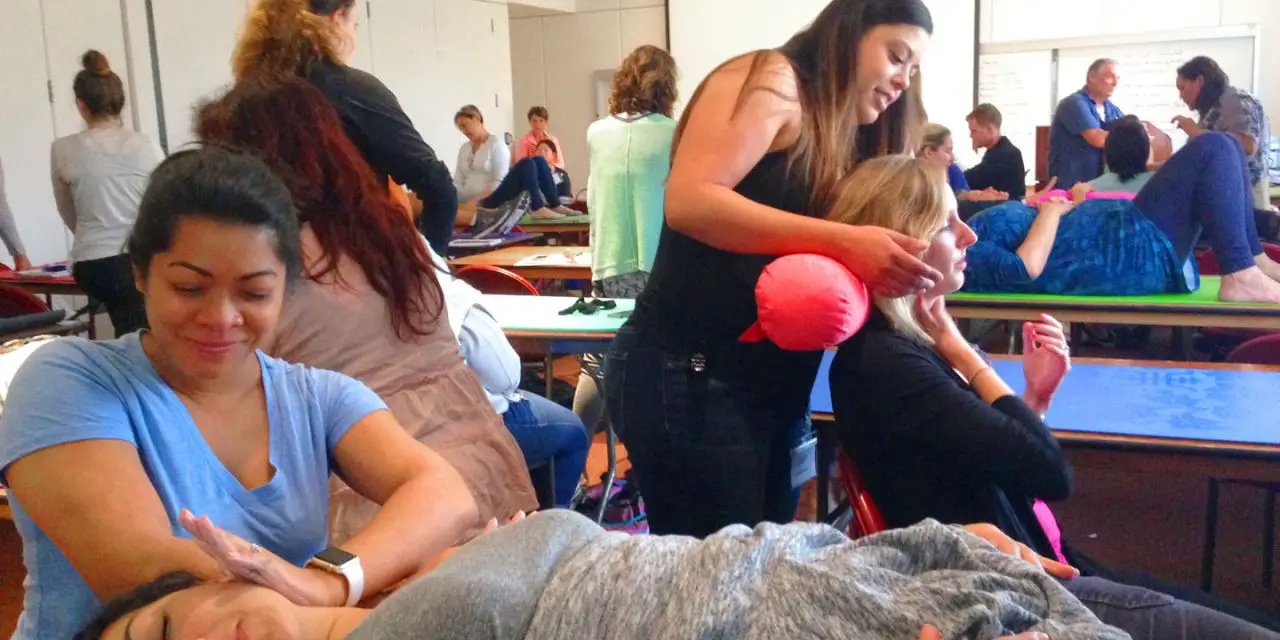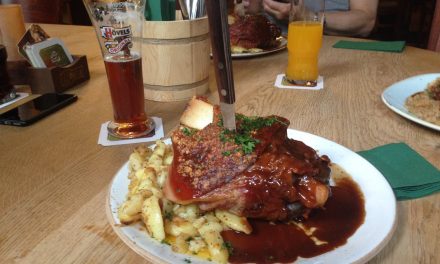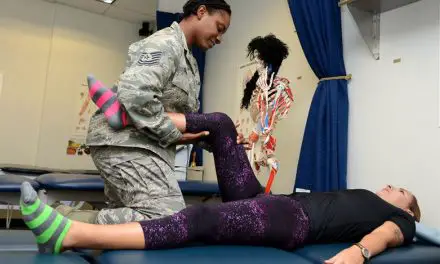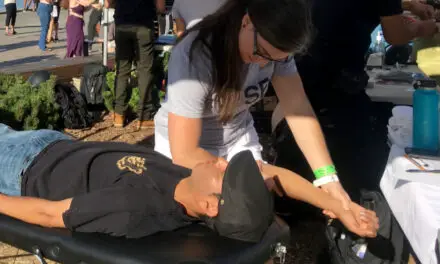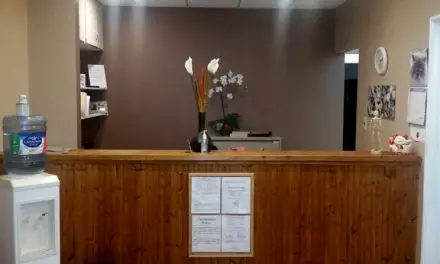Finding reliable information relating to massage therapy is tough for both clinicians and the public, and finding continuing education courses (CECs) that are up-to-date on the latest understanding of pain, movement, and touch based on good science and humanities may be even tougher. This is a problem many massage and other manual therapists encounter when they search for CECs to renew their license or certification. Who wants to pay and attend a class that is based on outdated or inaccurate information that can trickle down to clients, patients, and the public?
Science and humanities matter in medicine and healthcare, and it is a continual balance of meeting the needs of patients and the public with professional ethics. While science has shaped civilizations technology, communication, government, and medicine, it still needs humanities (e.g. psychology, anthropology, history, political science) to serve as a guide on “why” we do what we do.
Science journalist John Horgan argued, “…it is precisely because science is so powerful that we need the humanities now more than ever. In your science, mathematics and engineering classes, you’re given facts, answers, knowledge, truth. Your professors say, ‘This is how things are.’ They give you certainty. The humanities, at least the way I teach them, give you uncertainty, doubt, skepticism.”
For example, if a patient believes her low back pain is caused by a mild scoliosis that her physician had told her is the cause of her pain, how would you communicate with her given your understanding of the biopsychosocial (BPS) model of pain and health?
If a patient had a previous “success” with a certain type of treatment that has been shown to be no better than a placebo effect, what would you do and how would you communicate to that patient?
The selected courses and continuing education unit (CEU) providers offer some solutions to these problems. While most are less about hands-on techniques, they are more about how therapists communicate and apply the science and humanities behind the human pain experience, which can be used with almost any modality you already use.
Paula Jaspar (Canada)
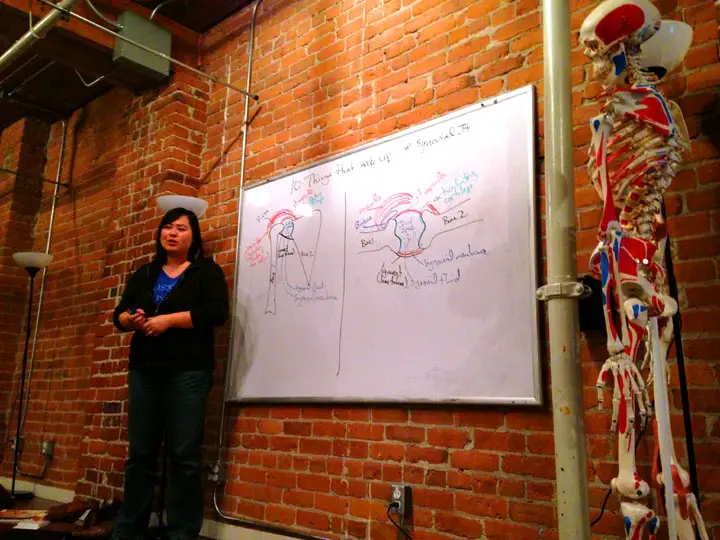
Paula Jaspar teaches synovial joint anatomy at Langara College in Vancouver, BC. Photo courtesy of Diana M. Romero.
A 20-plus-year veteran in massage therapy, Paula Jaspar founded Family Center Therapeutics in 2017 in Vancouver, British Columbia, a clinic that focuses primarily for expecting women. A graduate from West Coast College of Massage Therapy in 1997, Paula currently teaches various topics relating to pregnancy, labor, postpartum depression and anxiety, complications of pregnancy, and delivery.
“I think many therapists forget that pregnancy is a normal physiological presentation,” Paula said. “It is actually a demonstration of health excellence. I teach because there are many myths of treatment for pregnant individuals and massage. I teach so that pregnant people receive non-discrimatory care.”
In addition to the basic anatomy and physiology courses that Paula teaches relating to women’s health, she also teaches informed consent and critical thinking as part of the foundations for massage therapists.
“We consider various approaches such as the biomechanics versus the biopsychosocial model when considering treatment approaches. We focus on consideration of the presentation, anatomy and evidence on treatment approaches and considerations of precautions.”
Paula’s family background in medicine steered her toward a healthcare career, but it was not a straight line.
“My road to massage therapy was a short one. I come from a medical family. My father was a family physician and my mom was a nurse,” Paula said. “I grew up carrying my dad’s doctor bag to his home visits and sitting in the nursing station at the hospital as he did his rounds. I was eager to visit people as I was often offered, cookies, milk, or candy, such as mints or gumdrops. My father often said that my presence was better than any medicine that he could give.
“I considered going into medicine and I spent a year in nursing school at University of British Columbia. I found that nursing was not a good fit for me. I wanted more time with my patients to connect vs practice procedures on. I did consider becoming a doctor, but I met my ex-husband by then and wanted to start a family. I ended up working at the YMCA and received a complimentary massage therapy treatment. I was interested in the work.
“The following fall in 1994, I did the introductory massage weekend and was hooked. I liked the physicality, the time spent with people and that it is a regulated health care profession. I applied and began my schooling in 1995. I wrote my board exams in 1998.
“Originally I wanted to work with palliative care. My father passed away from cancer when I was 12, and I spent many days rubbing lotion into his dry skin. I wanted to provide comfort during the transition off the mortal plane. It was difficult work and I needed balance which brought me to treating pregnancy. Instead of witnessing those leaving the earth, I witness babies coming earthside. It is rewarding and humbling work.”

Photo courtesy of Paula Jaspar
Given her work, personal, and academic experience, Paula wants to contribute more to the massage therapy profession, like challenging the status quo in massage education, especially during the Covid-19 pandemic.
“I want to reduce myths and fears of care to patients. I have supported knowledge transfer in regards to pregnancy and postpartum care. I have also been a resource during this current pandemic,” she said.
“I want to challenge current thinking processes. Why have procedures been the way they have been? Is there evidence for application? Who does the framework serve? Much of massage therapy education has been historical and narrative. How can we frame the work to align with medicine?
“Completing my Masters of Education allowed for more academic thinking, and I would like to explore that realm more. To critically comment on issues at hand and to begin to develop a more common vocabulary that allows all massage therapists to communicate in a clear and concise manner would be a good first step.
“I would also like to redefine the role of the massage therapist, looking beyond the reductionist view of pain management or relaxation. To consider how massage therapy intersects with other professions and explore the potential for the profession.”
For more information about Paula’s classes and how to sign up, visit: www.vanfct.com/education
Walt Fritz (USA)
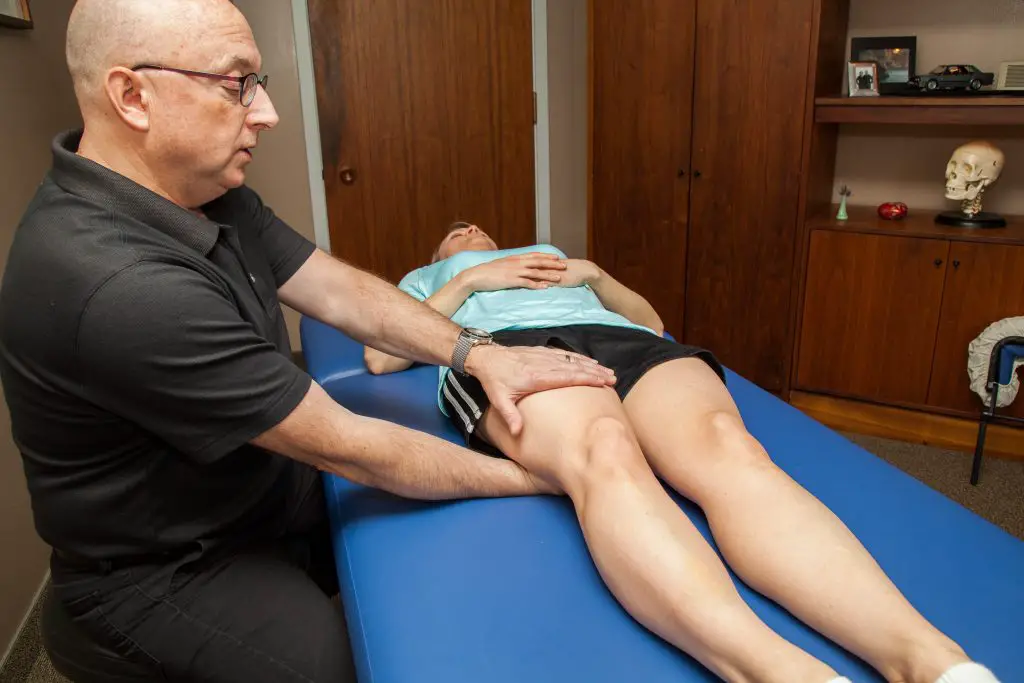
Walt Fritz demonstrates a ‘myofascial release’ on the subject’s upper leg while keeping the narrative behind the hands-on work aligned with science. Photo courtesy of Walt Fritz.
Physical therapist Walt Fritz, who practices in Rochester, New York, is one of the few CEU providers who uses an updated narrative behind myofascial release. He has been teaching on his own since 2007 internationally, including across the U.S. and Canada, the U.K., Hong Kong, Australia, and New Zealand. Since he started his private practice in 2000, he has made several “changes” in how he understands and explains how manual therapy works. He has moved on from the traditional myofascial release narrative.
“I pursued the physical therapy profession after a few stumbles while in college. Like many, it took a bit of time to determine my direction, but I saw physical therapy as a worthwhile career,” Walt said. “I’ve worked in a wide range of patient settings, including hospitals, early intervention, developmental disabilities, and home care.
“I settled into a manual therapy-based private practice in 2000, which fostered my growth and interest in teaching the style of therapy I use with my patients. I am a lifelong learner and have discovered much about how manual therapy can help with pain and movement problems. This understanding moves beyond seeing problems as stemming from a single tissue and has adapted my approach to reflect these changes.
While many physical therapists view manual therapy as a “joint-specific mobilization or manipulation”, Walt uses a more general definition. Manual therapy is any hands-on approach to treat patients in pain. This can be applied to massage therapists, chiropractors, osteopaths, and even to some degree, physicians and nurses who use affective touch as part of their care.
“Rather than using older, silo-based models that focus on one specific tissue, structure, or perceived pathology, I look at the multifactorial nature of therapeutic interactions,” Walt said. “Using up-to-date understandings of neuroscience and human behavior will enable us to see the larger picture of how our hands-on work can influence the human being, not just their tissues.”
Currently, Walt offers “An Introduction to the Evidence and Science” and a full-length course “Manual Therapy for Voice and Swallowing Disorders Hands-On Course,” which are online and are approved by NCBTMB.
“This course presents a patient-led model in a slow-sustained type of manual therapy input,” Walt said. “However, the principles can easily be applied to any sort of manual therapy or massage.”
Walt still sees patients in person at his private practice in Lima, New York. He continues to apply what he teaches to his treatments.
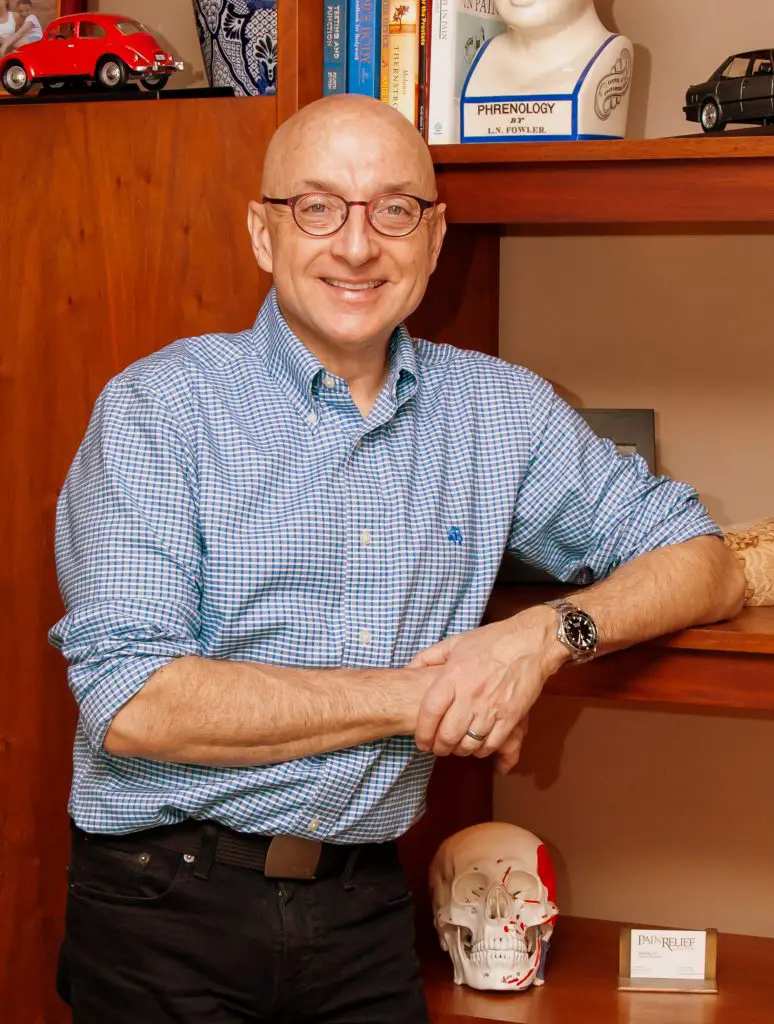
Photo courtesy of Walt Fritz.
“Through my courses and my research and writings, I hope to understand that manual therapy has effects far beyond the magic of the tissues that have been taught and followed for much of manual therapy’s history,” he said. “While there have been great strides in quantitative and qualitative research of these effects, little has trickled down to clinicians and schools teaching those clinicians. While such change doesn’t happen overnight, broadening the understanding of manual therapy impacts on clinicians is what I hope to change.
Given the current Covid-19 pandemic, Walt currently offers online continuing education courses only. For more information on CEUs and how to sign up, visit www.WaltFritzseminars.com.
Eric Purves (Canada)
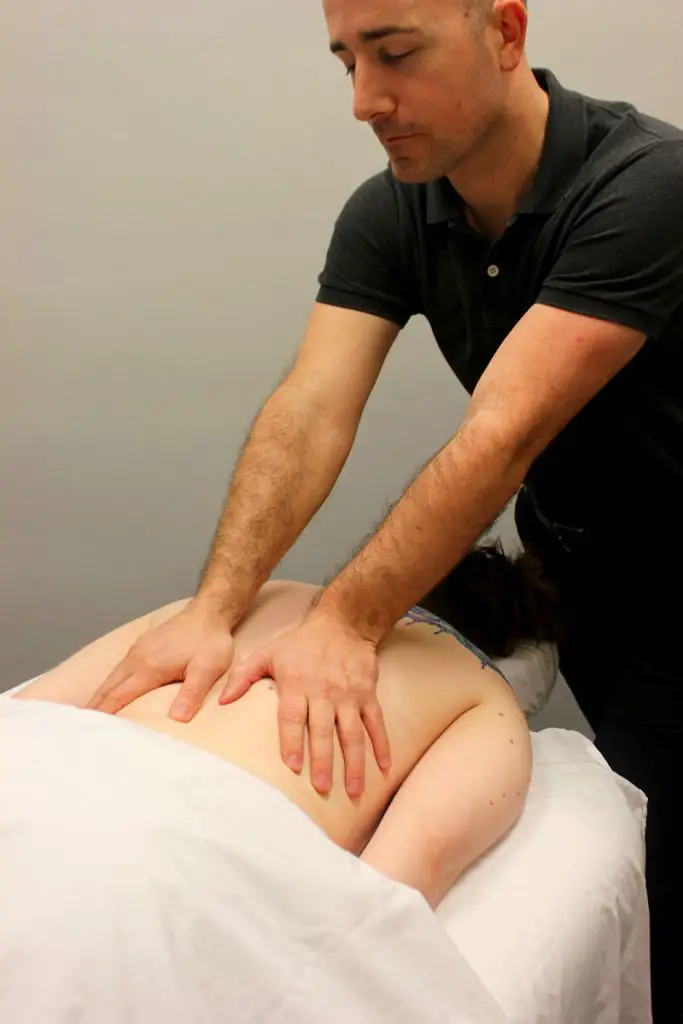
The narrative behind how massage therapy is just as important as the hands-on work. Photo courtesy of Eric Purves
A former varsity soccer player at the University of Victoria in Victoria, British Columbia, Eric Purves had decided to become a registered massage therapist (RMT) after a RMT treated him for an adductor strain. After graduating from West Coast College of Massage Therapy in 2006 and working for a few years, he and a business partner opened Achieve Health, a multidisciplinary clinic in his hometown.
“After that first appointment with the RMT, I was pretty convinced this is what I wanted to do someday,” Eric reflected. “When it came down to making a decision about my future, I had to decide what kind of lifestyle I wanted to live and being an RMT seemed to provide me with so much freedom as well as a great standard of living. I don’t think I have ever regretted my decision.”
Teaming up with fellow RMT Jamie Johnston, who runs The Massage Therapist Development Centre, Eric currently teaches Clinical Applications of Pain Science: Manual Therapy, Exercise and Rehabilitation Principles for RMTs.
“We created this course because we had noticed RMTs were reluctant to incorporate movement into their treatments and many didn’t feel comfortable in how to provide homecare exercises,” Eric said. “This course covers the current science of pain and the value and limitations to manual therapy as a stand-alone intervention. We spend a lot of time covering how to modify movements and how to use therapeutic exercises for pain control, and to create self-efficacious behaviors.
“Our objective is to make this material fun to learn and easy to apply clinically.”
This year, Eric and Jamie partnered with another RMT Jocelyn Kirton in a more specific course: Clinical Pain Science for the Low Back, Pelvis and Hips. This overlaps with the broader course about pain science.
“Jocelyn has been a welcome addition to our education team as she teaches on how to use a psychologically-informed and trauma-informed reasoning framework when assessing and treating patients suffering with abdominal and pelvic pain,” Eric said.
During the Covid-19 lockdown in Canada, Eric stayed productive and created a “self-directed course” that covers everything he teaches in a live course. Like a remote college class, students pace themselves in the learning.
“It’s called Clinical Pain Science for Manual Therapists,” Eric said. “It is geared towards RMTs, but anyone who makes a living doing manual therapy and is interested in adapting their practice by incorporating current evidence would benefit.”
The course contains more than 15 hours of lecture and hands-on demonstrations, which comes with research papers, workbooks, and quizzes. Students get access to these materials for life, and the content is updated regularly as scientific research and findings change.
“RMTs who take my courses will gain an understanding of the complexities of the human pain experience, and they will learn that most of the traditional ways we were educated are incomplete,” Eric said. “By reconceptualizing pain and starting to think of pain as a subjective experience that is unique to each individual, it opens up so many more opportunities for treatment and management.
“We no longer have to search for something to fix, learn a special technique, or gather a list of acronyms, which are all variations of pushing, pulling, and twisting the skin. They will walk away with current evidence-informed principles and strategies that can be applied to their practice immediately.”
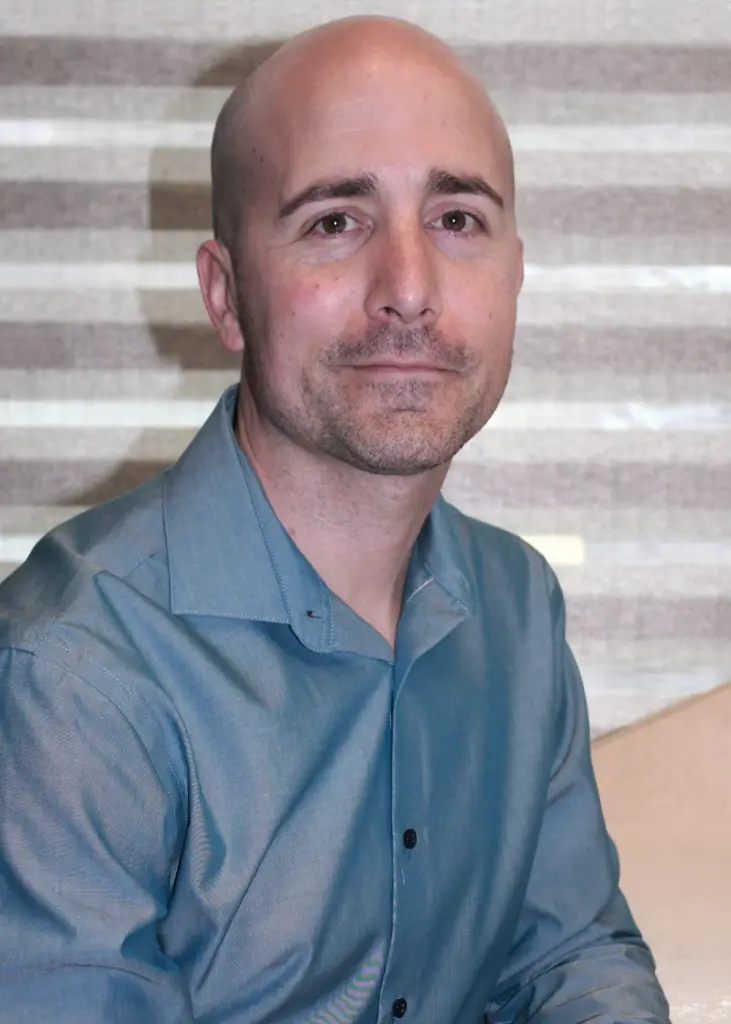
Photo courtesy of Eric Purves
As a veteran of six years of teaching science-based CECs to the RMT communities across Canada, Eric believes that what he teaches should be the fundamental knowledge that all healthcare professionals should have.
“I am an advocate for change in how our curriculum is structured, how we are educated, and how we are viewed by other healthcare professionals,” Eric said. “If these changes in curriculum and education are realized, I believe that RMTs will be able to obtain similar workplace opportunities as other allied healthcare professionals.
“As a healthcare provider, if you do not understand the complexities of pain and don’t appreciate the multifactorial nature of it, then how are you supposed to provide informed treatment and supportive self-management strategies? The number one reason people come to see an RMT is because they are experiencing pain, which is stopping them from enjoying life or engaging in activities that are important to them.
“If my profession can start to change the unhelpful pathoanatomical and tissue-based narratives about pain, then I believe this can greatly help increase our public and professional perception.”
For more information on CEUs and how to sign up, visit EricPurves.com.
Beret Loncar (USA)

Beret Loncar hopes to some of her work experience and knowledge as a registered massage therapist in Canada to the U.S. Photo courtesy of Beret Loncar.
Beret Loncar is both trained in Ontario, Canada, as a RMT and in New York City as a licensed massage therapist (LMT.) Before the Covid-19 pandemic, she taught a course at her practice—Body Mechanics Orthopedic Massage—on informed consent, which is where therapists educate a patient or client about the risks vs. benefits of a treatment, what to expect from a treatment, and alternatives to it.
“Right now [Body Mechanics] teaches nothing due to the pandemic,” Beret said, “but I also teach a course through Prema Yoga Institute that is ‘Pain Physiology for Yoga Therapists’. It is a science-based course and we use Neil Pearson’s textbook ‘Yoga and Science in Pain Care.’”
Beret emphasizes that informed consent is not simply the patient or client giving the therapist permission to do the treatment. The process of informed consent is the interaction between the therapist and the patient, which includes “good interview skills, client-centered treatment, acting as a [patient] advocate, creating clear boundaries, and describing what you are going to do.
“You can have all the knowledge in the world and if you cannot describe what you are about to do, your interaction will not feel safe or have the benefit of a positive interaction,” Beret said.
Beret started out as a pre-med to become a physician or nurse before deciding to become to RMT. “I clearly was not cut out for either,” Beret said, regarding her first two career options. “Years later, I moved to Canada and needed a visa to stay in the country. I found out that massage therapy here was a medical track and so I applied to the program to stay in Ontario.
“I did not know that Ontario follows a completely different standard than the U.S. Who thought massage would be different?

Photo courtesy of Beret Loncar.
“I hope I can bring some of the standards of the RMT community to the U.S. At the ground level, I am teaching my staff when they come on board, and then I also mentor business owners. I know as well that we have influenced the business around us and what the customer base is looking for. In the U.S., the economy will drive the need for a science-based practice. We have to make it look successful and needed.”
For more information about classes in 2021, visit Body Mechanics Orthopedic Massage.
Jason Erickson (USA)
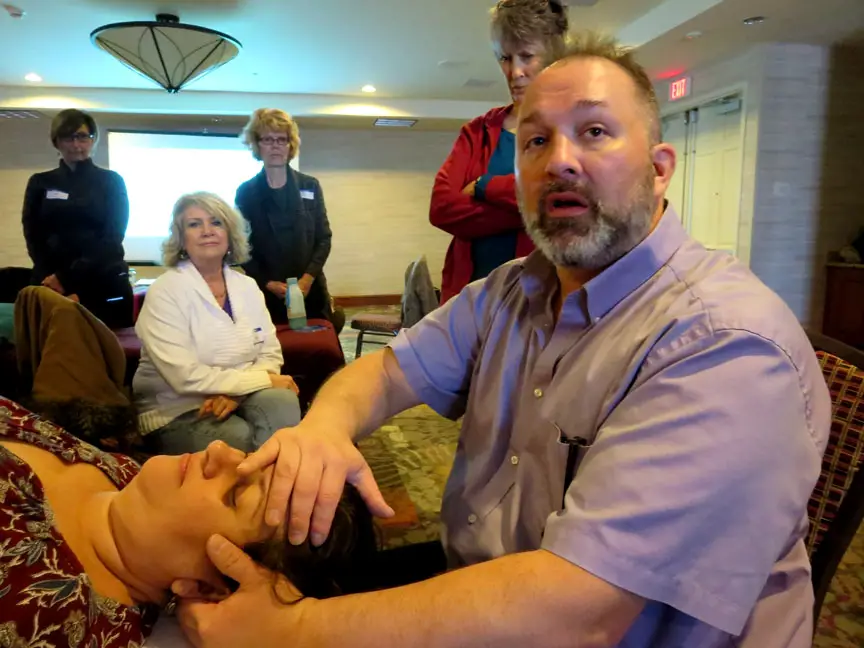
Photo courtesy of Jason Erickson.
Having experienced chronic pain for more than ten years prior to becoming a licensed massage therapist, Jason received help from a registered massage therapist who had moved to Minnesota and a chiropractor who encouraged him to exercise at a tolerable level. His recovery gave Jason a reason to quit his sedentary marketing job and started massage school, graduating from Northwestern Health Sciences University in 2006 in Minnesota.
Since then, he has been working both as a certified personal trainer and a LMT, working primarily with clients with chronic pain or athletes who have trouble training or doing basic daily activities.
“I no longer cared much about marketing,” he said. “I decided to help other people to find ways of experiencing pain relief.”
Jason is currently teaching continuing education courses in massage therapy at Eagan Massage Center at Eagan, Minnesota. His courses are on Dermoneuromodulation (DNM), which is based on the current understanding of pain, including the biopsychosocial model, neurophysiology, and neuroanatomy.
These courses include:
- Research: Correlation, Causation, and Common (Non)Sense: This course covers critical thinking and basic research literacy relating to massage therapy, other manual therapies, and pain.
- Intro to Dermoneuromodulation: This covers the basic concepts of pain science, gentle hands-on skills based on skin stimulation of cutaneous nerves, and communication skills for intakes and client education.
- Give Them Hope: Intro to Working with People in Pain: This class discusses key concepts in pain science and explores practical applications in manual and movement therapies. Emphasis is placed on understanding the needs of chronic pain patients.
- Intro to Hot DNM Pillossage: This course combines training in pain science and DNM concepts with the use of heated flax pillows—a simple, relaxing way of combining thermal therapy with manual therapy.
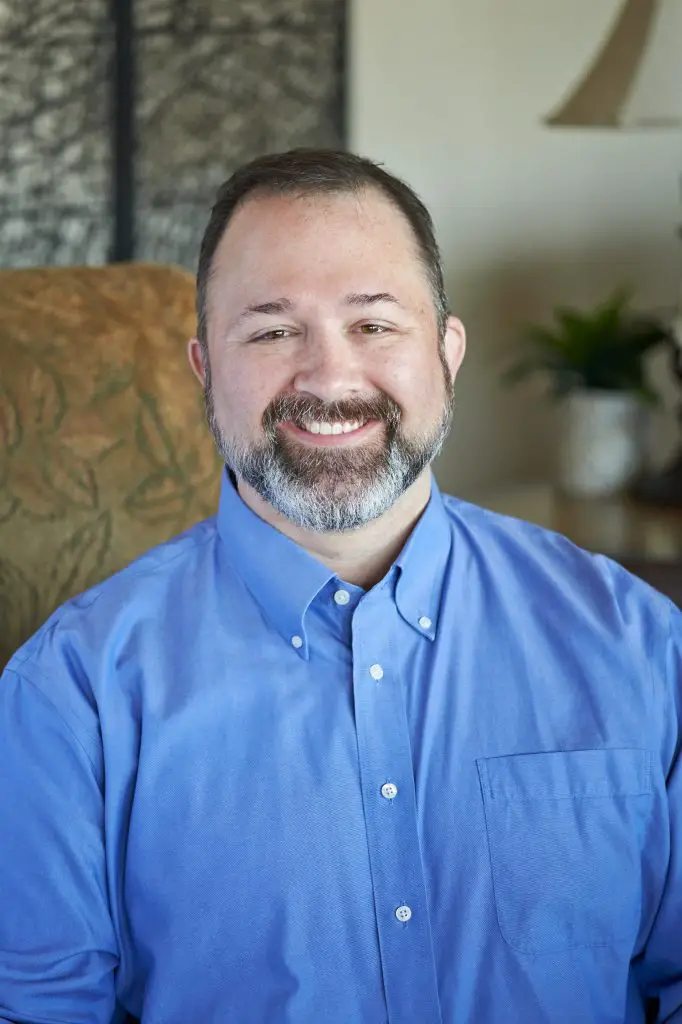
Photo courtesy of Jason Erickson.
The classes are a combination of theory and hands-on practice, which can even seasoned massage therapists and other manual therapists to improve their existing work. “Massage therapists have diverse needs, and my courses are designed to meet different sets of needs,” Jason said. “All of my classes provide practical recommendations and guidance on how to use the presented information appropriately. To fit each patient’s unique needs, the courses that include practicing specific hands-on techniques also include guidance on changing those techniques as needed.
“My goal is to bring hope to clients and their therapists. I want as many people as possible to experience pain relief via educating as many therapists as possible,” Jason said.
For more information about CEUs and how you can sign up, visit HealthArtes.com.
Mark Olson (USA)
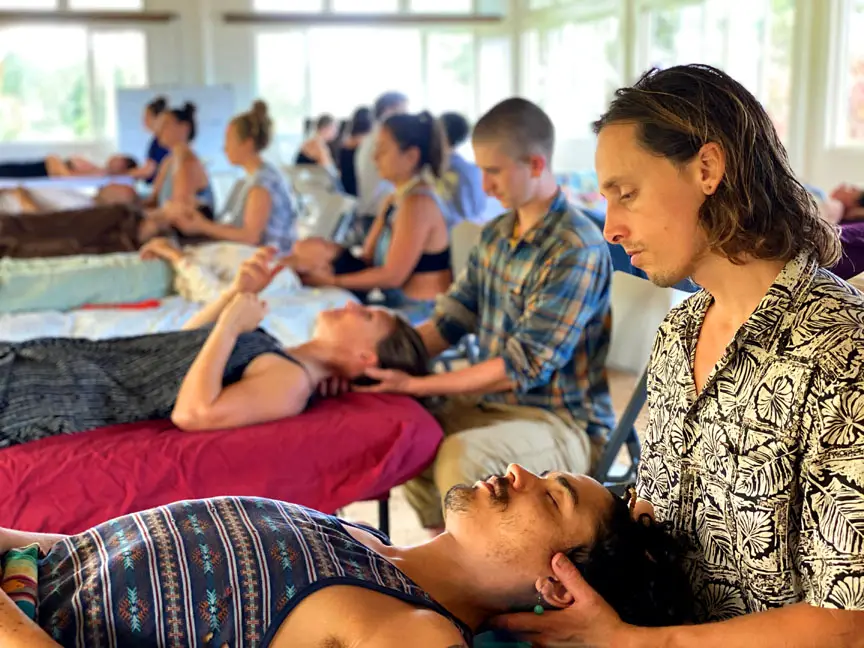
Students at PCAB in Hawaii practice massage therapy and bodywork. Photo courtesy of Mark Olson.
In addition to informed consent, trauma-informed care is another standard massage therapists should consider, especially when working with clients or patients who have suffered from emotional and/or physical abuse. Dr. Mark Olson, who is the director of the Pacific Center for Awareness and Bodywork (PCAB) in Princeville, Hawaii, teaches massage therapists about how to work with clients who had experienced trauma while maintaining their scope of practice.
“I teach a number of courses on neuroscience, trauma, and bodywork, including a series on Trauma-informed Relational Skills for Bodyworkers because trauma is so pervasive, its effects are so counterintuitive, and the client-therapist relationship is a key component of any session,” Mark said.
“Course participants will learn about trauma (both shock and developmental) and how it may relate to various aspects of a manual therapy session, particularly the client-therapist relationship. In my course, therapists will learn how to recognize and respond to trauma-driven autonomic nervous system responses when they arise. They will also learn how to better recognize and respond to clients’ embodied relational dynamics in a manner that avoids re-traumatization and optimizes the outcomes of the session.”
Mark started to become an LMT in 2000 after he earned his doctorate in neuroscience at the University of Illinois. While he was a graduate student, he decided that after he got his doctorate, he thought it would be “worthwhile” to pursue his interest in massage therapy with the knowledge and experience he has.
“When I became the owner and director of PCAB in 2014, I meticulously revised the courses to be organized around a nervous system perspective that includes the latest science on interoception, pain, and trauma, all of which makes for a more seamless integration with a biopsychosocial treatment model,” Mark said.
“At the time, I wasn’t thinking of it in terms of a career, but eventually I came to realize in neuroscientific terms how much more powerful and profound bodywork is relative to how I (like most of society) previously conceptualized it.”
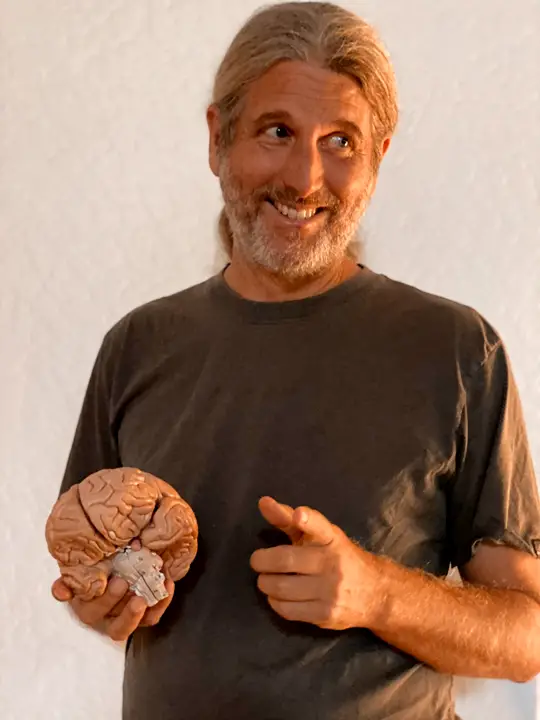
Photo courtesy of Mark Olson.
“I want to raise awareness about trauma in a manner that has far-reaching implications for the well-being of any client or community member and the success of one’s bodywork practice. Some of these ideas are so important and so counterintuitive that I think that applying them can significantly raise the bar of how healthcare providers could show up for their clients.”
For more information about the course and how to sign up, visit PCAB.
A native of San Diego for nearly 40 years, Nick Ng is an editor of Massage & Fitness Magazine, an online publication for manual therapists and the public who want to explore the science behind touch, pain, and exercise, and how to apply that in their hands-on practice or daily lives.
An alumni from San Diego State University with a B.A. in Graphic Communications, Nick also completed his massage therapy training at International Professional School of Bodywork in San Diego in 2014.
When he is not writing or reading, you would likely find him weightlifting at the gym, salsa dancing, or exploring new areas to walk and eat around Southern California.

